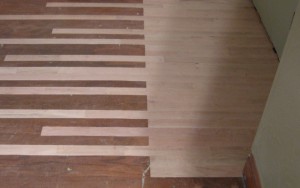
Seaming new flooring into old flooring will minimize (but not completely hide) the impact of the repair.
Floors are incapable of lying.
Wood floors, especially those in homes as old as the homes in The Fan District, tell a story. The large majority of the homes in The Fan were built in the period between 1900 and 1930 making these homes literally a century old. Over their lifespan, a home will have had multiple owners and each one will have cared for the home differently. The floors will go a long way in telling you about the how the home was treated and what has been done to the home throughout its history.
Using the floors as a guide will help an inspector in identifying potential issues during the course of the inspection. The first thing floors will indicate is whether a space is part of the original home or if it was added and/or captured. For the most part, it is impossible to perfectly match floors. New wood does not match old wood and the new stain never quite matches the old stain. Likewise, where the floors meet, usually near the door jamb, will show either a transition strip (always a giveaway) or a different pattern than elsewhere. When an inspector sees a change in floor patterns, they know to pay special attention to how the space is heated, cooled, insulated and how the roofs are joined. Additions, if not properly integrated into the original envelope, will tend behave differently from a temperature standpoint. Likewise, the roof, if over an addition, will usually be a different age or type and will require different maintenance techniques or schedules. The floors will tell you that some additional sleuthing is required.
Floors will also indicate whether a home had a catastrophic event occur and/or a prolonged period of neglect. If a large swath of flooring differs from flooring near by, then do some harder looking. Fire, water or termite damage is a most often times the culprit. Examining the flooring system from beneath will usually tell the rest of the story and most importantly, what was done to remedy the problem. Floor joists that have been repaired are common in older homes but how the repairs were made is the main issue. Expecting a century old home to not have needed repair at some point is naive, but expecting those repairs to be made using best practices is not. Let the floors be your guide.
The last thing to note when looking for clues about a home is to look at the floor where it meets the base trim. The number of times the floors have been refinished will be evident in the corners. The floor sanders can never quite get into the corners and the amount of flooring that has been sanded away will be best illustrated there. If there is a great difference in depth, then the floors have been refinished multiple times and may lack the depth to be refinished again.
Nothing is time proof. Buying a home in a mature neighborhood like Richmond’s Fan District means accepting age in exchange for proximity, culture and walkability. Inspect your home well and use the clues provided to help understand what you are buying.
Rick Jarvis is one of the Founders of the One South Realty Group in Richmond, Virginia. He can be found at Google+ and Twitter
